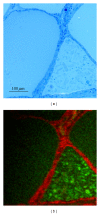Iodine Content and Distribution in Thyroid Specimens from Two Patients with Graves' Disease Pretreated with Either Propylthiouracil or Stable Iodine: Analysis Using X-Ray Fluorescence and Time-of-Flight Secondary Ion Mass Spectrometry
- PMID: 22953073
- PMCID: PMC3420651
- DOI: 10.1155/2012/842357
Iodine Content and Distribution in Thyroid Specimens from Two Patients with Graves' Disease Pretreated with Either Propylthiouracil or Stable Iodine: Analysis Using X-Ray Fluorescence and Time-of-Flight Secondary Ion Mass Spectrometry
Abstract
Patients with Graves' disease can be medically prepared before surgery in different ways, which may have various effects on iodine stores. Thyroid specimens were collected at surgery from two patients pretreated with propylthiouracil (PTU) and stable iodine, respectively. A quantitative analysis of iodine content was performed using X-ray fluorescence (XRF) in frozen tissue and a qualitative analysis of aldehyde-fixed material with Time-of-Flight Secondary Ion Mass Spectrometry (TOF-SIMS). Iodine concentrations were 0.9 mg/mL and 0.5 mg/mL in the thyroid tissue from the patients treated with PTU and stable iodine respectively. TOF-SIMS showed iodine in the follicle lumina in both. However, in the PTU case, iodine was also seen within the thyrocytes indicating accumulation of iodinated compounds from uninhibited hormone release. XRF and TOF-SIMS can be used to follow iodine distribution within the thyroid and the intricate processes following the different medical treatment alternatives in Graves' disease.
Figures



References
-
- International Commission on Radiological Protection (ICRP) Publication 23. Oxford, UK: Pergamon Press; 1975. Reference man: anatomical, physiological and metabolic characteristics.
-
- Cooper DS. Antithyroid drugs. The New England Journal of Medicine. 2005;352(9):905–917. - PubMed
-
- Saller B, Fink H, Mann K. Kinetics of acute and chronic iodine excess. Experimental and Clinical Endocrinology and Diabetes. 1998;106(supplement 3):S34–S38. - PubMed
-
- Wolff J, Chaikoff IL. Plasma inorganic iodide as a homeostatic regulator of thyroid function. The Journal of Biological Chemistry. 1948;174:555–564. - PubMed
Publication types
LinkOut - more resources
Full Text Sources

